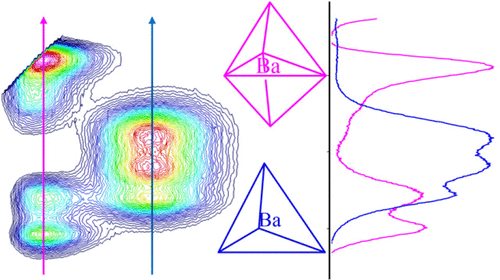当前位置:
X-MOL 学术
›
J. Phys. Chem. A
›
论文详情
Our official English website, www.x-mol.net, welcomes your
feedback! (Note: you will need to create a separate account there.)
Luminescence of Atomic Barium in Rare Gas Matrices: A Two-Dimensional Excitation/Emission Spectroscopy Study
The Journal of Physical Chemistry A ( IF 2.7 ) Pub Date : 2018-08-24 00:00:00 , DOI: 10.1021/acs.jpca.8b05140 Barry Davis 1 , John G. McCaffrey 1
The Journal of Physical Chemistry A ( IF 2.7 ) Pub Date : 2018-08-24 00:00:00 , DOI: 10.1021/acs.jpca.8b05140 Barry Davis 1 , John G. McCaffrey 1
Affiliation

|
A detailed characterization is made of the distinct sites occupied by atomic barium isolated in the three rare gas hosts Ar, Kr, and Xe in excitation scans extracted from the recorded total 6s6p 1P1 → (6s)21S0 fluorescence. Extensive use has been made of two-dimensional excitation/emission (2D-EE) spectroscopy to achieve a comprehensive characterization for the wide variety of sites present in the Ba/RG matrix systems. The 2D-EE technique has proved to be a very powerful method to probe the effects of strong intersite reabsorption when extensive spectral overlap occurs between emission and resonance 6s6p 1P1 ← (6s)21S0 absorption of barium atoms occupying multiple sites. Two-dimensional excitation/emission scans have also been used in this study to monitor the effects of sample annealing and thereby identify the thermally stable sites of isolation. Sites of the same type occupied by atomic barium in the three host solids are identified in resolved excitation spectra and are associated on the basis of the observed matrix shift versus host polarizability. Following site associations, the photophysical properties of each matrix site were characterized revealing that the Stokes shift was greatest in the blue site, smallest for the violet site, and intermediate for the green site. The emission temperature dependences and excited state lifetimes were recorded, indicating that measured radiative lifetimes of 4–5 ns were in good agreement with the gas phase value of 8.4 ns when corrected for the effective field of the solids. The only exception to this was the blue site in Ba/Xe, where a nonradiative quenching channel exists even at 9.8 K that competes effectively with the nanosecond fluorescence. An unusual, asymmetric 2 + 1 excitation band has been recorded for atomic barium in the three rare gas hosts in addition to the threefold split, Jahn–Teller bands typically observed for P ← S absorptions of matrix-isolated metal atoms. Possible assignments of the sites responsible for these band shapes are made on the basis of recent spectral simulations obtained from molecular dynamics calculations on the Ba/Xe system.
中文翻译:

稀有气体基质中原子钡的发光:二维激发/发射光谱研究
在从记录的总6s6p 1 P 1 →(6s)2 1 S 0荧光中提取的激发扫描中,对三个稀有气体主体Ar,Kr和Xe中分离出的原子钡所占据的不同位点进行了详细的表征。二维激发/发射(2D-EE)光谱已得到广泛使用,以实现Ba / RG矩阵系统中存在的多种位点的全面表征。2D-EE技术已被证明是一种非常有效的方法,可以在发射和共振之间发生广泛的光谱重叠时探测强烈的位点间重吸收。6s6p 1 P 1 ←(6s)2 1 S 0吸收钡原子占据多个位点。二维激发/发射扫描也已用于本研究中,以监测样品退火的影响,从而确定隔离的热稳定位点。在解析的激发光谱中识别了三种主体固体中原子钡所占据的相同类型的位点,并根据观察到的基质位移与主体极化率进行了关联。在位点关联之后,对每个基质位点的光物理性质进行了表征,揭示了斯托克斯位移在蓝色位点最大,对于紫色位点最小,对于绿色位点为中间。记录了发射温度的依赖性和激发态寿命,这表明测得的4-5 ns的辐射寿命与8的气相值非常吻合。校正固体有效场时为4 ns。唯一的例外是Ba / Xe中的蓝色位点,该位置甚至在9.8 K时仍存在一个非辐射淬灭通道,可与纳秒荧光有效竞争。除了三倍分裂的Jahn–Teller谱带,通常在基质分离的金属原子的P←S吸收中观察到一个异常的不对称的2 +1激发带,用于三类稀有气体主体中的原子钡。根据从Ba / Xe系统上的分子动力学计算获得的最新光谱模拟,对造成这些能带形状的位点进行了可能的分配。8 K与纳秒荧光有效竞争。除了三倍分裂的Jahn–Teller谱带,通常在基质分离的金属原子的P←S吸收中观察到一个异常的不对称的2 +1激发带,用于三类稀有气体主体中的原子钡。根据从Ba / Xe系统上的分子动力学计算获得的最新光谱模拟,对造成这些能带形状的位点进行了可能的分配。8 K与纳秒荧光有效竞争。除了三倍分裂的Jahn–Teller谱带,通常在基质分离的金属原子的P←S吸收中观察到一个异常的不对称的2 +1激发带,用于三类稀有气体主体中的原子钡。根据从Ba / Xe系统上的分子动力学计算获得的最新光谱模拟,对造成这些能带形状的位点进行了可能的分配。
更新日期:2018-08-24
中文翻译:

稀有气体基质中原子钡的发光:二维激发/发射光谱研究
在从记录的总6s6p 1 P 1 →(6s)2 1 S 0荧光中提取的激发扫描中,对三个稀有气体主体Ar,Kr和Xe中分离出的原子钡所占据的不同位点进行了详细的表征。二维激发/发射(2D-EE)光谱已得到广泛使用,以实现Ba / RG矩阵系统中存在的多种位点的全面表征。2D-EE技术已被证明是一种非常有效的方法,可以在发射和共振之间发生广泛的光谱重叠时探测强烈的位点间重吸收。6s6p 1 P 1 ←(6s)2 1 S 0吸收钡原子占据多个位点。二维激发/发射扫描也已用于本研究中,以监测样品退火的影响,从而确定隔离的热稳定位点。在解析的激发光谱中识别了三种主体固体中原子钡所占据的相同类型的位点,并根据观察到的基质位移与主体极化率进行了关联。在位点关联之后,对每个基质位点的光物理性质进行了表征,揭示了斯托克斯位移在蓝色位点最大,对于紫色位点最小,对于绿色位点为中间。记录了发射温度的依赖性和激发态寿命,这表明测得的4-5 ns的辐射寿命与8的气相值非常吻合。校正固体有效场时为4 ns。唯一的例外是Ba / Xe中的蓝色位点,该位置甚至在9.8 K时仍存在一个非辐射淬灭通道,可与纳秒荧光有效竞争。除了三倍分裂的Jahn–Teller谱带,通常在基质分离的金属原子的P←S吸收中观察到一个异常的不对称的2 +1激发带,用于三类稀有气体主体中的原子钡。根据从Ba / Xe系统上的分子动力学计算获得的最新光谱模拟,对造成这些能带形状的位点进行了可能的分配。8 K与纳秒荧光有效竞争。除了三倍分裂的Jahn–Teller谱带,通常在基质分离的金属原子的P←S吸收中观察到一个异常的不对称的2 +1激发带,用于三类稀有气体主体中的原子钡。根据从Ba / Xe系统上的分子动力学计算获得的最新光谱模拟,对造成这些能带形状的位点进行了可能的分配。8 K与纳秒荧光有效竞争。除了三倍分裂的Jahn–Teller谱带,通常在基质分离的金属原子的P←S吸收中观察到一个异常的不对称的2 +1激发带,用于三类稀有气体主体中的原子钡。根据从Ba / Xe系统上的分子动力学计算获得的最新光谱模拟,对造成这些能带形状的位点进行了可能的分配。











































 京公网安备 11010802027423号
京公网安备 11010802027423号